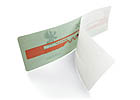MARKET TRENDS: Smart Labels

The U.S. smart label industry, which includes electronic article surveillance (EAS), radio frequency identification (RFID) and interactive packaging labels, is currently dominated by EAS labels. However, starting in late 2004, a number of industry mandates - most notably from Wal-Mart and the U.S. Department of Defense - began to force companies to use RFID labels, which had been perceived as too costly. The higher use of RFID labels allowed economies of scale to begin to be achieved in the production of RFID tags, which serve as the brains of these smart labels. The standardization of RFID systems allows products from many vendors to work together, easing the transition to RFID technology and thereby supporting label demand. As a result, standardization - along with improved manufacturing technologies - will continue to drive down the costs of RFID tags. By 2014, RFID labels, which were around 10% of total smart label demand in 2004, will account for more than 85% of the market, while the share of EAS labels will drop sharply.

As the nascent RFID market develops over the next several years, U.S. demand for smart labels is projected to increase more than 11% annually to 8 billion units in 2009. With the advent of item-level RFID tagging on higher-priced items early in the next decade, demand will grow even more sharply to over 50 billion units in 2014. While the fastest increases are expected for RFID labels, interactive packaging labels (including thermochromatic and time-temperature indicator products) will also show strong growth. In contrast, the dominant EAS segment will remain almost stagnant, with demand increases of only 2.2% per year.
For more information, contact Corinne Gangloff, The Freedonia Group Inc., 767 Beta Drive, Cleveland, OH 44143-2326; phone (440) 684-9600; fax (440) 646-0484; e-mail pr@freedoniagroup.com ; or visit http://www.freedoniagroup.com .
Links
Looking for a reprint of this article?
From high-res PDFs to custom plaques, order your copy today!



